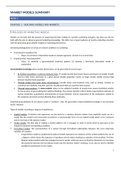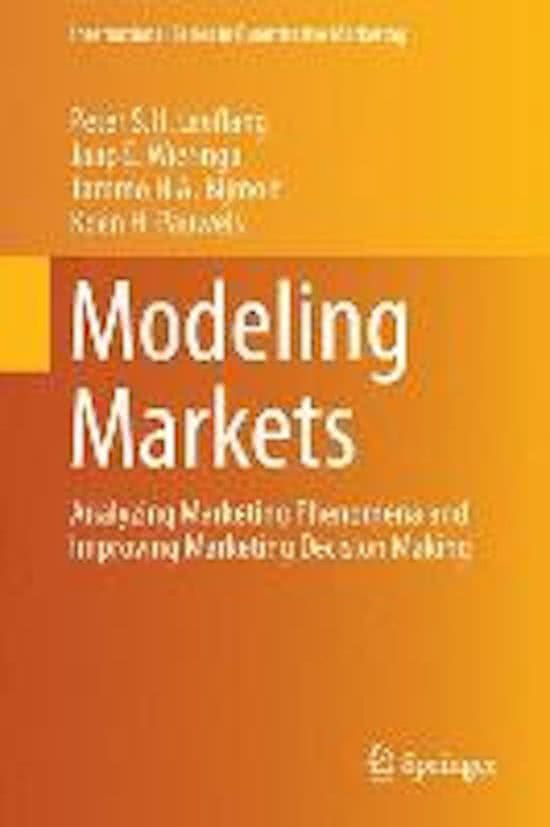MARKET MODELS SUMMARY
WEEK 1
CHAPTER 1 – BUILDING MODELS FOR MARKETS
TYPOLOGIES OF MARKETING MODELS
Models can be built with the purpose of supporting decision making of a specific marketing managers, but they can also be
built with the aim to advance general marketing knowledge. The latter has a target audience of mostly marketing scientists
with the goal being generalizable insights in marketing phenomena.
Ehrenberg distinguishes two kinds of research traditions in marketing:
§ Theoretical-in-Isolation (TiI)
o Steps: (1) construct a theoretical model or analysis approach; (2) test it on a set of data
§ Empirical-then-Theoretical (EtT)
o Steps: (1) establish a (generalizable) empirical pattern; (2) develop a (low-level) theoretical model or
explanation.
Generalizable knowledge about market phenomena can be generated in several ways:
§ By finding regularities in customer behavior data smaller brands have fewer buyers and buyers of smaller brands
tend to make fewer purchases in a given period (double jeopardy); buyers of larger brands exhibit unusual high
behavior loyalty (triple jeopardy).
§ Through studies that cover many circumstances (usually many cross-sectional units, such as brands, markets or
countries) and relatively long time periods. Usually panel data are used for that purpose.
§ Through meta-analyses meta-analysis refers to the statistical analysis of results from several individual studies
for the purpose of generalizing the individual findings. The primary benefit is that it delivers generalized estimates of
various elasticities, quantitative characteristics of buyer behavior, and an assessment of the moderators related to
the empirical and study context affecting these estimates.
Empirical generalizations do not always result in “numbers”. Also, the generation of generalizable knowledge is not restricted
to B2C research.
Types of models according to degree of explicitness:
§ Implicit models: if intuition and experience are the basis for a solution, decision makers have implicitly made use of a
model. But the model is not necessarily recorded in a communicable form; it is an implicit model which so far is present
only in the brain of the decision maker.
§ Verbal models: the first step in making a model explicit is for a manager to state in words what he perceives as the
important elements surrounding a problem.
§ Formalized models: the representation of a system through formalized relationships between the most important
variables of a system.
o A logical flow model (or graphical/conceptual model) represents an extension of the verbal model by the use of
a diagram, which shows the sequence of questions and of actions leading to a solution of the problem. The flow
diagram makes explicit what the manager has put in words, which can serve as basis for discussion. It may show
discrepancies between the formalized model and the decision maker’s thinking. It can also be used to identify
possible inconsistencies in the model.
1
, o A formalized mathematical model represents a part of the real-world system by specifying relations between
some explanatory (predictor) variables and some effect (criterion) variable(s).
§ Numerically specified models: the various components and their interrelations are quantified. They are often the most
appropriate representations of real-world systems. Disadvantages are:
o Building and using models costs money, and the more complicated and the more explicit models become, the
more expensive they will be. Thus weighing the costs against the benefits will always be a necessary step in the
modeling process.
Advantages are:
o This model allows the decision maker to quantify the effects of multiple, and potentially conflicting forces.
Specifying a model numerically will provide precision to the statements that a price increase results in a sales
decrease and an advertising increase results in a sales increase.
o A numerically specified model gives management the opportunity to explore the consequences of a myriad of
actions, a capability which cannot normally be duplicated in the real world.
Types of models according to intended use:
§ Descriptive models are intended to describe decisions or other processes. A decision maker may wonder how particular
decisions are arrived at in her organization or by her customers and to that end a descriptive model may be applied.
§ Predictive models have as main purpose to forecast or predict future events.
§ Normative or prescriptive models have as one of their outputs a recommended course of action, which implies that an
objective is defined against which alternative actions can be evaluated and compared.
Types of models according to the level of demand:
§ Models for individual demand
§ Models for aggregate demand, where aggregate demand may refer to:
o The total number of units of a product category purchased by the population of all spending units. The
corresponding demand model is called an industry sales or product class sales model.
o The total number of units of a particular brand bought by the population of all spending units. The demand
model is then a brand sales model.
o The number of units of a particular brand purchased, relative to the total number of units purchased of the
product class, in which case the demand model becomes a market share model.
The same measures can be defined at the segment and individual consumer level leading to models with different
levels of aggregation: market, store, segment, household etc.
BENEFITS FROM USING MARKETING DECISION MODELS
§ Direct benefits: companies invest in model building presumably because it leads to better decisions. “Better” meaning
contributing to the fulfillment of the company’s goals. In some cases it’s difficult to measure the benefits directly while in
other cases it’s straightforward. The measurement is complicated by the fact that a cost-benefit evaluation should be
carried out before the model is built and before it is implemented.
§ Indirect benefits:
o Improved understanding
o Models may work as problem-finding instruments. Problems may emerge after a model has been developed if
the model outcomes are contrary to expectations. Managers may identify problems by discovering differences
between their perception of the environment and a model of that environment.
o Information is often available but not used. Decisions could perhaps have been reversed if available information
had been used. Models can be instrumental in improving the process by which decision makers deal with
existing information.
2
, o Models can help managers decide what information should be collected. Thus models may lead to improved
data collection, and their use may avoid the collection and storage of large amounts of data without apparent
purpose.
o Models can also guide research by identifying areas in which information is lacking, and by pointing out the
kinds of experiments that can provide useful information.
o A model often allows management to pinpoint changes in the environment faster than is possible otherwise
(diagnostic capacity).
o Models provide a framework for discussion. If a relevant performance measure is decreasing, the model user
may be able to defend themselves to point to the effects of changes in the environment that are beyond his
control.
o A model may result in a beneficial reallocation of management time, which means less time spent on
programmable, structured, or routine and recurring activities, and more time on less structured ones.
THE MODEL BUILDING PROCESS
Stages in the model-building process (which is an iterative procedure):
1. Opportunity identification: a model builder has to evaluate whether the
development/use of a model can improve managerial decision making.
Ideally the model building and manager work together to define the
problem, to agree on an approach and to determine that the expected
benefits exceed the costs of model building.
2. Model purpose: the intended use of the model should be defined as
precisely as possible.
3. Model scope: model building can take place for a specific type of decision or
for a broader set of decisions.
4. Data availability: one reason a manager may ask for a model-building effort
is the increasing availability of large amounts of data.
5. Specification (representation/structure): is the expression of the most
important elements of a real-world system in mathematical terms, which
involves two major steps:
a. Specifying the variables to be included in the model, and making a
distinction between those to be explained (the dependent or
criterion variables), and those providing the explanation (the
explanatory, independent or predictor variables).
b. Specifying the functional relationship between the variables. For example, the effects of the explanatory
variables can be linear or non-linear, immediate and/or lagged, additive or multiplicative, etc.
6. Estimation: is the determination of parameter estimates for a model. Apart from data collection issues, we need to
identify techniques to be applied for extracting estimates of the model parameters from the data collected. The
choice of a technique depends on:
a. The kind of data available and/or needed
b. The kind of variables (observable/unobservable) in the model
c. The assumptions (of a statistical nature) that are necessary and/or acceptable
d. The computational effort and expense considered to be reasonable
There is often a trade-off between statistical qualities of the estimators, and flexibility (and realism) in the
specification. Based on data availability, we consider: data-based parameterization (parameter estimation from
historical data) and subjective estimation (judgment-based parameter estimation).
3






